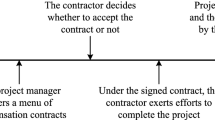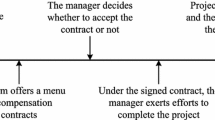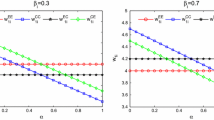Summary
Extended incentive contracts allow the contractor to select target cost at his own discretion. Two suitably devised design functions ensure that the assessment of excessive target cost automatically reduces both target profit and possible gains from cost underruns. It is shown that extended incentive contracts stimulating risk neutral contractors to reveal their cost expectation truthfully induce risk averse contractors to assess the target cost far higher than expected cost.
Zusammenfassung
Einfache Anreizverträge zur Kostenreduktion sind durch drei Design-Parameter (Zielkosten, Zielprofit, Kostenteilungsparameter) gekennzeichnet. Bei erweiterten Anreizverträgen treten an die Stelle der Design-Parameter zwei Funktionen der vom Auftragnehmer selbst festzulegenden Zielkosten. Diese (vom Auftraggeber geeignet vorzugebenden) Funktionen reduzieren bei zu hohen Zielkosten automatisch den Zielprofit als auch etwaige durch Kostenunterschreitungen resultierende Zusatzgewinne. Hauptaugenmerk gilt einer Klasse von erweiterten Anreizverträgen, die bei risikoneutralen Auftragnehmern die wahrheitsgemäße Angabe der erwarteten Kosten erzwingt. Es wird gezeigt, daß es für risikoaverse Auftragnehmer generell im eigenen Interesse liegt, die Zielkosten höher als die erwarteten Kosten anzusetzen.
Similar content being viewed by others
References
Bamberg G (1989) Risk sharing and subcontracting. In: Bamberg G, Spremann K (eds) Agency theory, information, and incentives. 2nd edn. Springer, Berlin Heidelberg New York, pp 61–79
Bamberg G, Coenenberg AG (1989) Betriebswirtschaftliche Entscheidungslehre. 5. Aufl. Vahlen, München
Bamberg G, Spremann K (1981) Implications of constant risk aversion. Z Oper Res 25:205–224
Bamberg G, Spremann K (eds) (1989) Agency theory, information, and incentives. 2nd edn. Springer, Berlin Heidelberg New York
Chew SH, Kami E, Safra Z (1987) Risk aversion in the theory of expected utility with rank dependent probabilities. J Econ Theory 42:378–381
Ferschl F (1975) Nutzen- und Entscheidungstheorie. Westdeutscher Verlag, Opladen
Fisher IN (1969) An evaluation of incentive contracting experience. Nav Res Logist Q 16:63–83
Gonik J (1978) Tie salesmen's bonuses to their forecasts. Harvard Business Rev pp 116–122
Kadane JB, Winkler RL (1987) De Finetti's methods of elicitation. In: Viertl R (ed) Probability and Bayesian statistics. Plenum Press, New York, pp 279–284
Laux H (1990) Risiko, Anreiz und Kontrolle. Principal-Agent-Theorie. Einführung und Verbindung mit dem Delegationswert-Konzept. Springer, Berlin Heidelberg New York
Osband K, Reichelstein S (1985) Information-eliciting compensation schemes. J Public Econ 27:107–115
Pfingsten A (1989) Incentives to forecast honestly. In: Bamberg G, Spremann K (eds) Agency theory, information, and incentives. 2nd edn. Springer, Berlin Heidelberg New York, pp 117–133
Pratt JW, Zeckhauser RJ (1985) Principals and agents: The structure of business. Harvard University Press, Boston
Reichelstein S, Osband K (1984) Incentives in government contracts. J Public Econ 26:257–270
Reichelstein H-E, Reichelstein S (1987) Leistungsanreize bei öffentlichen Aufträgen. Z Wehrtech pp 44–49
Savage LS (1971) Eliciting of personal probabilities and expectations. J Am Stat Assoc 66:783–801
Thomson W (1979) Eliciting production possibilities from a wellinformed manager. J Econ Theory 20:360–380
Trost R (1989) Zur Axiomatisierung und den Konsequenzen der dualen Theorie der Entscheidungen unter Risiko. In: Kistner K-P, Ahrens JH, Feichtinger G, Minnemann J, Streitferd L (eds) Operations Research Proceedings. Springer, Berlin Heidelberg New York, pp 357–362
Weber M, Camerer C (1987) Recent developments in modelling preferences under risk. OR Spektrum 9:129–151
Yaari ME (1987) The dual theory of choice under risk. Econometrica 55:95–115
Author information
Authors and Affiliations
Additional information
Dedicated to F. Ferschl on the occasion of his 60th birthday
Rights and permissions
About this article
Cite this article
Bamberg, G. Extended contractual incentives to reduce project cost. OR Spektrum 13, 95–98 (1991). https://doi.org/10.1007/BF01719933
Received:
Accepted:
Published:
Issue Date:
DOI: https://doi.org/10.1007/BF01719933




